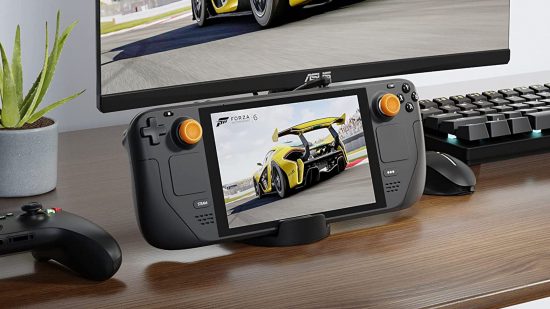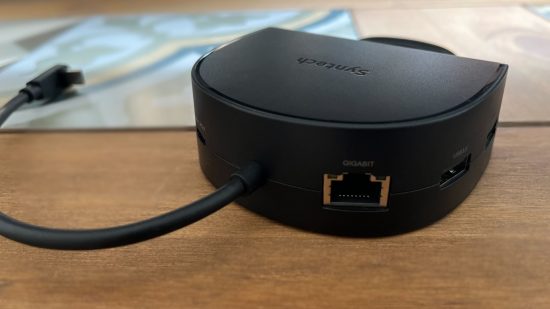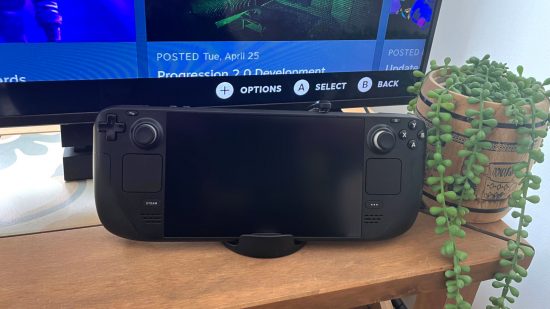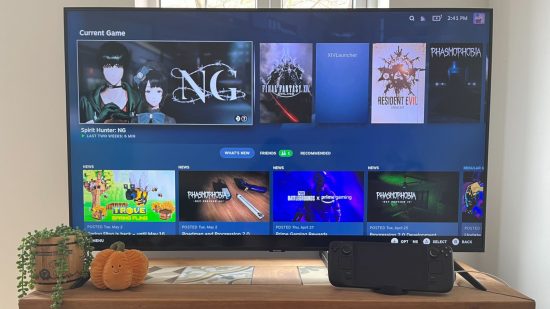Despite loving all platforms big and small, I’ve always been a PC gamer at heart – and I’ve got the Steam library to prove it. Naturally, getting my paws on a Steam Deck to access that expansive library without being shackled to my desktop was very appealing to me, as is the idea of being able to hook it up to a TV if I fancy lounging about.
However, while the Steam Deck is certainly one of the more affordable current-gen consoles on the market right now, it still costs a pretty penny – and Valve’s Steam Deck Dock piles a hefty price on top of that. Luckily, there are a few budget alternatives that allow you to hook up your Steam Deck to an HDMI, ethernet, or other assorted ports – one of which is the Syntech 6-in-1 Dock. But is it any good? Or would you be better off saving up and splashing out on the official deck dock? Let’s take a look.
The Syntech 6-in-1 Dock is made of lightweight plastic with a rubber grip inside the divet where you place your device, and a rubber ring on the base of the port to prevent slipping. It has one central USB-C cable leading out of the back which hooks around to plug into your device. The connector on the cable is tough and is hooked at a right angle, allowing it to slot into your Steam Deck comfortably without sticking out at an odd angle as a straight connector would.
It comes neatly packaged in a little box, which contains a short instruction manual and a complimentary set of orange silicone joystick covers. The joystick covers are a nice touch and I certainly appreciate their inclusion, though they personally don’t appeal to me as they’re quite tough and bumpy, making them uncomfortable for me to use over long play sessions.
Aside from that, the dock comes with no additional cables. To connect it to the mains or a charging point, you need your own USB-C cable and charging plug, and you also need to get your own HDMI and ethernet cables if you want to connect those, too. However, I personally have no problem with this – and I’m sure most of us have plenty of those cables laying around the house anyway – it’s just something to bare in mind when making the purchase.
As you might have guessed, the dock boasts six separate ports – three USB 3.0 ports, which are great for plugging in peripherals such as controllers or wireless keyboard and mouse dongles, an ethernet port for ensuring those snappy download speeds, and the USB-C input for charging your device through the dock.
Even without using the HDMI and ethernet ports, it makes for a great stand and charging station for your Steam Deck, with the added bonus of being able to attach and charge peripherals. Despite its light weight, the dock feels sturdy and surprisingly well-made and is very steady when you place your Steam Deck on it. It also looks super sleek and neat, making it the perfect little stand to slip under your monitor or TV.
In terms of its HDMI connection, the Syntech dock works like a dream. Its HDMI 2.0 4K@60Hz output poses no latency or input lag issues with both my PC monitor and TV. It takes a few seconds to plug it into your TV or monitor and connect your Steam Deck, and before you know it you’re playing your Steam games on the big screen. I hooked up my Switch Pro controller through the Steam Deck’s Bluetooth and was able to play all my favourite games on my TV, even plugging my controller into one of the dock’s ports when it needed charging.
I’ve not done a thorough, comparative test of the dock’s gigabit ethernet output, but I did notice faster game download speeds when I hooked it up to my router, and experienced no connectivity drops during online gaming sessions. The option to hook your Steam Deck up to the ethernet is certainly an appealing one across the board, especially if your wifi connection is shaky, and this neat little gadget delivers on that front with seemingly no issues.
Outside of its core use as a Steam Deck dock, the Syntech dock can also act as a base for other devices that use a USB-C port such as smartphones, tablets, and the Nintendo Switch. I have found it to be a nifty little stand and charging station for my phone if I want to play games or watch videos, as the cable comfortably hooks around, and there’s plenty of room to angle your phone just right without the need for pop stands or flip cases.
On the other hand, it’s not the most convenient when it comes to the Nintendo Switch, as the Switch USB-C port is in the bottom of the console, so it doesn’t rest in the dock properly while plugged in. This isn’t really an issue, as the dock isn’t built around housing the Switch – it’s just something to keep in mind if that’s one of the reasons why you’re eyeing this dock up.
Overall, the Syntech Steam Deck Docking Station is a neat little piece of kit that offers a more affordable alternative to Valve’s official dock. Sitting at an RRP of $49.99 on Amazon US and £36.99 on Amazon UK (a price that frequently drops through vouchers and promotional deals), as opposed to the Steam Deck Docking Station’s unchanging $89.99/£79.00, it feels far less of a financial gut-punch after forking out for the Steam Deck itself, while still offering all the same inputs and outputs you need to turn your deck into a fully functioning home console.
Whether you’re looking for a neat stand to show off your Steam Deck and keep its battery consistently topped up, a way to connect your Steam Deck to an ethernet for faster download speeds, or the opportunity to play your Steam library while lounging on the couch in front of your sofa, the Syntech Deck Dock is a sleek and simple way to deck out your tech and a great budget addition to your set-up.
If you’re still in the market for some handheld fun, check out our list of the best portable gaming consoles. We’ve also got guides to the best Samsung phones, the best iPads, and the best rugged smartphones for even more top-notch tech.



